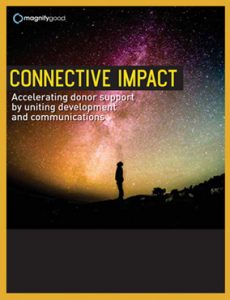Collective impact. I’m sure you’ve heard these words before. It’s a term used in philanthropy to describe what happens when organizations from different sectors agree to solve social problems using a common agenda. When they align their efforts and measure success together.
Through our work with nonprofit organizations we’ve seen an opportunity to apply the principles of Collective Impact to the internal structure of the organizations. We passionately believe doing so will result in greater impact for the organizations.
This opportunity presented early in our engagements with clients. Typically, we’re hired to help organizations connect with their external audiences. An engagement begins with us interviewing leadership, current and prospective donors, board members, staff, and volunteers. Over time, we’ve noticed a very interesting trend: most organizations are laser-focused on their external audience, but pay little attention to their internal audiences. More specifically, they lack a connection between their donor development and communication departments.
Donor development works to build relationships. They match donors with opportunities that make a difference in the world.
Communications has a vision for branding and digital communications, and how to use them to better connect with people. But they may not connect these activities directly to how the organization can raise more money.
Both teams are focused on what they do best. But are they united in achieving the mission?
Is everyone going in the same direction on the way to the same goal?
Unfortunately, the answer is no in 100 percent of the clients we work with and 100 percent of the organizations that participated in a follow-up research project on the subject.
There are two issues driving this dynamic
First, we’ve observed a lack of a strategic planning process between donor development and communications…a coordinated effort to work hand-in-hand to strategically develop programs that will attract and retain donors. This isn’t to say these departments aren’t working hard or collaborating, but they are operating either independently, or communications functions in a support role to development planning.
The second problem has to do with the duplication of efforts occurring between these departments. A duplication of efforts with database management and a duplication of efforts with the development of content.
Donor development uses Raiser’s Edge, DonorPerfect, Salesforce or another database to track donor activity. Communications uses Constant Contact, MailChimp, AWebber or another database to deliver marketing material. Here’s the problem: the databases contain many of the same names, but lack interoperability which limits the ability to share meaningful data. The duplication of names is redundant and inefficient.
The duplication of efforts also occurs in the content each department is developing. Communications is busy developing newsletters, press releases, social media posts, blogs and other brand-focused materials while donor development is developing direct mail appeals, brochures and email campaigns. This duplication of time and resources limits the opportunity for development and communications to collaborate in the creation of content that will help attract new prospects, convert prospects into donors and nurture current donors along the digital moves management cycle.
Connective Impact to the rescue:
Connective Impact works much the same as Collective Impact. It brings together diverse groups within your organization to help them achieve more together than they can alone. Or in silos.
Connective Impact happens when organizations align their donor development and communications efforts around three things:
- Increasing the prospect base.
- Elevating the conversion of prospects to donors.
- Using new techniques and technologies to increase giving.
It does this by using shared goals, strategies, and tactics to connect development and communications people and functions. It brings new communications techniques and methods into your organization’s existing operations and skill sets.
But most importantly, it connects all communications efforts with donor wants and needs.
Is it easy to create Connective Impact? The answer is No.
But the upside is undeniable.
Connective Impact will provide your organization with the road map and tools you need to leverage the dynamic of the Philanthropic Revolution. And the ability to tap into people’s desire to give and make a lasting impact on your cause, your community and the world.
Want to learn how? Come back often. We’ll dive deeper and explore each element of Connective Impact in subsequent blog posts.
Or, Download the eBook Connective Impact: Accelerating donor support by uniting development and communications.




